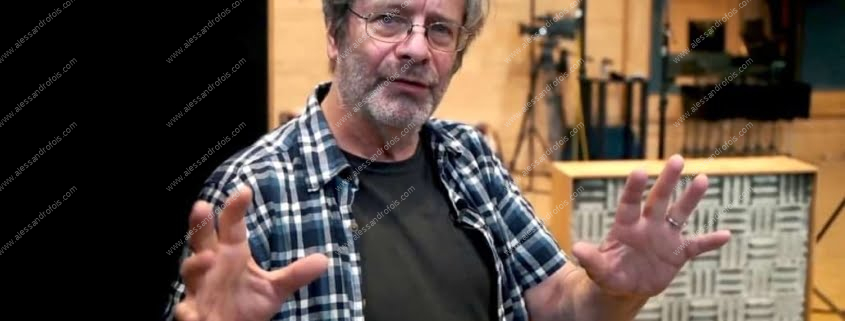George Messenburg - Interview - 18 July 2012
- Author Profile
- Recent posts
Pianist, Composer, Arranger, Sound Engineer, Writer, Blogger
Alessandro Fois is a musician, composer, pianist, arranger and sound engineer. Since 2018, he has also been a writer, blogger and webmaster. He currently resides in Ivrea (Turin) where, in addition to the above activities, he manages Lycnos, studio for audio, video and web services, and the recording studio Glamour Recording Studio.
The interview
Equipment
Let's talk about the equipment you like to use.
The simplest thing to say is that I hate everything! Even my products. I wouldn't be inspired to improve equipment if I liked it too much.
So I have problems with everything, with all microphones and preamps, really with everything.
I do not love anything about the various equipment; instead, I virtually pursue total transparency of the performance of each processor and fight everything that hinders it, relentlessly trying to improve its performance.
So... do you prefer analogue or digital consoles?
I really wish I could answer.
Of course I use analogue microphones, with the special exception of the Neumann D, which I think is good; the KM D is in fact an exceptional microphone.
I like analogue processing: I use analogue limiters and equalisers, both my own processors and some made by other manufacturers.
I like to mix in the digital domain with a small console, first of all because it allows me to automate what I need, but also because I love to feel a mix, putting my hands on the controller and mixing by arm, not just drawing lines on a screen: I guess I can call it an analogue methodology on a digital console.
It is an old-fashioned way of working but with the improvements that can be determined by today's equipment.
Yes, we have learned to love DAWs because they allow us to correct every little forgotten or underestimated detail without having to do the mix all over again.
sometimes you have to deal with a bad vocal track or a bad trumpet; in jazz I often have to deal with trumpets, which often play the high notes in 'falsetto' in a way that is not always correct, but we can fix them if it is a good performance with small flaws.
Enough of the old practice of keeping mistakes to make honest jazz!
In these cases, the great strength of the DAW in the mix becomes evident: if I work on a mix and something sounds bad, I have the chance to fix it; the artist and I can either leave it as it is or fix it... it's a great chance!
Interactions with musicians
When you are with other musicians or when you are discussing recording or your methods, your positive energy shines through in your relationships with artists and towards the music.
In my recordings I really want the musicians to hear the whole mix, to feel part of the whole; and I want them to know that I am listening carefully to everything they do.
So I keep the contact alive and if I hear something that is not very good I communicate it in real time, maintaining a positive feel with the performer already during the recording; this helps to achieve good results in the studio through quick feedback.
So quickly establish a sense of trust.
I communicate something like: 'I'm listening to what you're doing, don't make mistakes because I won't edit with Pro Tools: if you don't perform well you'll have to do it again'.
Foreplay
Back to production. What are some of the first things you do when you start recording a band? Do you go into the recording room and take notes?
I consult with the band to talk about the project long before we meet in the studio
I go to their rehearsal room.
If they play in a club, I go and listen to them there.
We are talking about songs that have already materialised in a live performance or rehearsal.
If the songs are not there yet, let's talk about what they like, what they love, how they sound, their role models and how they perceive themselves, their future expectations.
Most of the time we are of the same opinion but sometimes we are not, so the relationship is nipped in the bud; this also happens because of me: I am too demanding, I want to know too much and I want to make a really good record, even according to my vision.
I often propose to carry out a pre-production with a singer and a guitarist in advance, to get a preview of the song in an essential form; sometimes we try to add percussion or another instrument that helps to better capture the expressive sense of the song, albeit in a synthetic manner.
Operations
We have seen in several of your videos which microphones you use and their positioning. Is there something you always do and something you never do in a studio?
This is difficult to say, because there is always something I do and there is never something I don't do; I can say that I always do something recurring and never avoid certain other things; the only rule is 'that there are no rules'.
Can you tell us more about the mixing phase? How do you deal with it?
I start with the first track and finally make a quick automated mix to save in the DAW.
The artist will take that mix home to listen to it and very often it will be that preliminary track that will become the guideline for refining the work.
Next I start mixing for real; as the mix grows and changes, I make a save of each highlight, so that I can later find it and recall it if necessary, so I also make reference notes on the various archived versions.
So if an artist says: 'You know I love the mix you made right after you put the lead guitar on', I look for that mix among the various previous saves, and often I have found that the artist was right.
This slightly discontinuous approach was better than the classic 'sit tight until you've finished mixing a track'.
For example, it took me many days to mix a Toto song: four fucking days to make a mix, way too long to work in a row without alternating with other types of interaction.
I prefer to pause in between, change listening perspectives, compare and recreate the right moods.
So you prefer to create the mix while recording. Do you have any kind of structure or working method for the mix?
I use about 6 different approaches when I start a mix from scratch:
One way is to develop a mix from scratch and go on to completion, another way is to start from scratch.
I have perhaps 3 different ways to start from scratch, varying which tracks to start with, and how to handle them.
One way is to listen to a demo of the song and move the faders until the most incisive source in the mix turns out to be the same one perceived most incisively in the demo.
Another way is to make the lead vocal and the most important backing instrument such as piano or acoustic guitar, electric guitar or whatever stand out as much as possible; in that case I start this way and then fill in the spaces with the other backing tracks.
Yet another way, which I often use for jazz: balance the complete rhythm section, then balance the saxophones, then balance the trumpets, then balance the submasters; in jazz you need to create a natural but firm balance between the sections.
After that, one can begin to take up the various requests, which are to be fulfilled by working more on sound than on volume.
What is your bus mix processing chain?
I almost always try to start mixing with all the necessary means at my disposal.
So I have all my effects at my disposal: reverb, delay... I use PCM96, UAD250 and Altiverb 7 a lot.
Then I assign the tracks to various subs: drums and percussion, bass, guitar, piano, lead vocals, other voices, string orchestra, sax, trumpets,.
And at the end I direct the submasters to a summing machine, i.e. to my small 8-channel analogue mixer, so that I can manage everything from there in premix, and then extrapolate the final mix from it.
But first I make a pre-master.
So, if I am trying to match a pattern, a sample or an example sound, I try to get close to it.
Finally, I will use one of my favourite limiters, for example the Massey 2007.
I don't like Waves L3, I don't like anything multi-band, I usually don't use multi-band, but I can't say never, because sometimes I use C4.
I never use a vocai rider, like the one from Waves, I prefer to mix by hand.
I therefore try to quickly obtain a pre-master that offers a satisfactory preview of my target and a good match to the reference model, if used.
So you are always trying to match something you have ...
Not exactly; I am there to create a mix for an artist who has an idea of what he wants, but if he does not have a clear idea, then I definitely propose 'my mix', starting from scratch, with no external reference points.
As for mixing versions, how many do you do?
As I said, if I did the recording first, I would have several versions saved during the various stages.
Be that as it may, I end up with a version that, apart from very minor retouches, should be OK.
I don't do stems: if asked, I take myself out of work.
Finally I will still deliver 2 versions, i.e. I will deliver 'my version' but also the 'version the artist likes', the one of which he said: 'It's a great mix, I like it, keep it. "
My work must always result in a product with good dynamic control and good equalisation.
When I export the mix for mastering, I remove the master bus from any dynamic processor but leave the Eq, because I want to allow the mastering engineer to operate at his best, especially with dynamics.
So the mastering engineer will get 2 versions from me, not 10 or 20.
Didactics
I would like you, as a lecturer, to talk about the evolution you see today for students who want to become sound engineers.
My colleagues and I believe that modern record productions desperately suffer from being destined for oblivion, as they often do not meet the requirements to be remembered.
I don't want to teach anyone how to make music, but I can say as an example: if we use live drums in this way... here comes the alchemy, here comes the recording creates the story.... and so with other choices that make the music more human and expressive.
By teaching students, who are themselves the future teachers, I achieve a multiplier effect of good ideas: they will become able to spread some good concepts and techniques and define what the art of recording is and also what it is not.
What is the strength of each of these areas? Audio engineering has its strengths, music production has its strengths, helping artists still has its strengths.
The most important thing to understand is: you must not repair an error generated in one of these areas by using the tools of another area, you cannot fix an arrangement or execution error by acting with Eq.
Instead, it is good, for example, to have the band really play together, creating a 'rehearsal room' interaction, to allow the performers to spontaneously work out the groove, phrasing, dynamics.
It is good to realise immediately that the drummer is not overdoing it, taking space away from the singer, because this could be unresolvable later.
Until you put it in place, you still don't know that you have the power to tell a drummer, "Just do it!"
It is always a good time to advise a drummer and anyone else to listen while he or she plays.
It's important to learn to let him hear what inappropriate crap I've played, to tell him, for example: What you are performing does not allow you to hear the details of the lead vocal; this is a very fine song, can you catch it? Get in the mood!".
Showing students how to be effective in a study is really important, even I don't think the above is what a student expects, usually their questions are: "Which plugin should I use on this?"
Instead, they have to learn that it is more often a matter of knowing how to listen; so we teach them how to perform effective critical listening, how to listen to details, explaining how they interact; from there, the concept of things to work on is formed, and the correct priorities are set.






Leave a Reply
Want to join the discussion?Feel free to contribute!